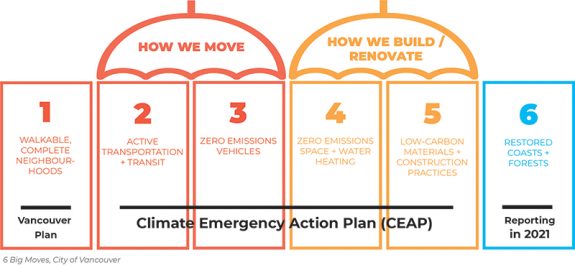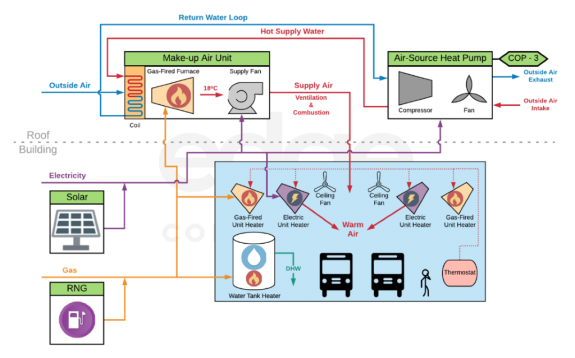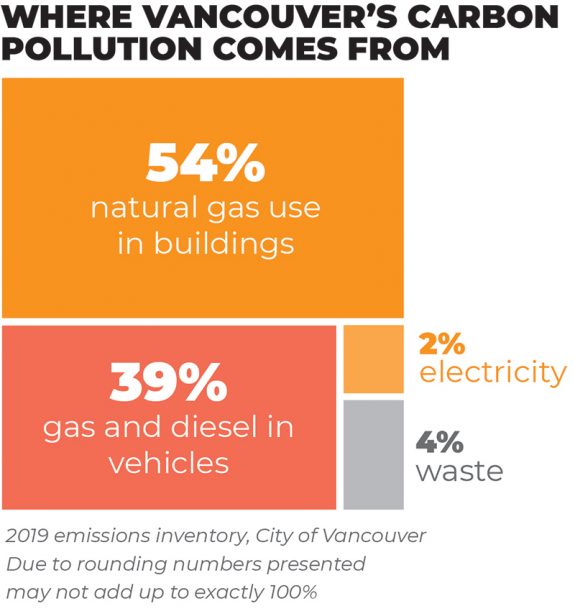Edge Consultants wholeheartedly congratulates the pioneering efforts by the City of Vancouver (CoV) that led to approval of the Climate Emergency Action Plan on 17th of November 2020.
Introduction
The Climate Emergency Action Plan (CEAP) outlines a road map to achieve four major changes to accelerate local climate action. Recommendations, included within the report, align with global efforts to limit average temperature increase to 1.5°C. This has been verified using climate modeling.
The road map focuses on reducing major sources of carbon pollution from the City. From the annual emissions inventory in previous years leading up to 2019, the major sources of carbon pollution were determined to be Building Operations and Vehicular Movement.
Background
The CEAP is not a standalone document, it sits within the context of many other previous works carried out by local and provincial bodies. Firstly, it builds on existing work done by the CoV such as the Climate Emergency Response (CER) and Zero Emissions Building Plan (ZEBP). Secondly, the report follows on from current provincial efforts such as BC Energy Step Code, CleanBC and Translink’s Transport 2050 strategy. Thirdly, the recommendations outline regulatory and collaborative measures to be undertaken by council and key industry players. Key industry players include utility providers, provincial entities and industry & trades associations, their participation is vital to the success of the measures identified.
The CER introduced the City’s six objectives for the decade, referred to as “Big Moves”. Each Big Move serves to guide the City’s work in response to the current climate emergency. The CEAP report provides a five-year game plan that tackles four of the six Big Moves. Efforts to accomplish Big Moves 1 and 6 are on-going and are targeted to be included in the coming months.

While carbon pollution generated in Vancouver (also referred to as scope 1 and scope 2 emissions in the CEAP) is a key indicator driving the CEAP strategy, a high priority was placed on incorporating equity into the plan by considering the most impacted communities, and working to ensure that the actions proposed do not overburden these communities. In developing the CEAP strategy, priority was also placed on reconciliation – ensuring that work and decisions were looked at from a First Nations and Urban Indigenous perspective. Finally, the City aims to bring about systematic change to facilitate individualistic climate action.
Structure
The report divides its action plan into two main umbrellas – “How We Move” and “How We Build/Renovate”. Each umbrella has corresponding Big Moves associated with the theme. Under a Big Move, there are specific targets and recommendations backed by strategic environmental analysis to meet the City’s carbon targets.
How We Move
Big Moves 2 & 3 recognize the benefits of a well-connected transit system and zero emissions commute in a low carbon economy. The resulting recommendations focus on a variety of measures such as restructuring parking legislature, pricing models, etc. The package of actions is a great read on expected lifestyle changes. You can read them here.



How We Build
We focus the spotlight on the “How We Build” umbrella which would streamline existing green building efforts in the regional industry. While Big Move 4 outline actions for new construction and existing building stock, Big Move 5 focuses majorly on the former.

CEAP Impact on Building Industry
Regulatory actions
Building on the success of ZEBP and the Green Buildings Policy for Rezoning, the City intends to streamline regulatory actions that support a carbon pollution limit for building operation and embodied carbon reductions for new construction materials. The phased approach to establishing legislature comes from enabling industry response and identifying potential in certain building types for retrofit opportunities.
For instance, with the proposed regulation, we foresee assisting more of our clientele with identifying waste heat opportunities to incorporate heat recovery strategies into the ventilation system. This shifts accountability to the design team to ensure optimal emissions performance post construction/renovation.
Market Transformation
A key step to decarbonizing the economy is boosting industry capacity and supporting owner action. The CEAP outlines engagement with various stakeholders such as contractors, engineers, manufacturers, and suppliers to enable the building industry to move towards low carbon technologies and materials. The recommendations depict collaborative action plans to develop financing tools, increase industry capacity of heat pumps, renewable energy, and whole-building lifecycle analysis for new construction.
There is a lot of focus on heat pump technology, which is increasingly seen as the path to a low carbon technology. A typical heat pump uses one unit of electricity to produce three units of energy using refrigerants as heat transfer media (see below for a typical application). The three-to-one energy production ratio is known as the Coefficient of Performance which gives us an indication of the heat pump’s efficiency i.e. 3 (or 300%). The more efficient your equipment, the better it is for the environment; therefore it is no surprise that the CEAP is evaluating measures to prescribe equipment with efficiencies greater than 1 for new construction and retrofits. The use of heat pumps (and other refrigerant using equipment) must be approached cautiously, with consideration given to fugitive emissions from refrigerant leakage. Refrigerants in North America have very high Global Warming Potential (GWP), with short term impacts (20-year) more severe than long term impacts (100-year) on global temperatures. Low-impact refrigerants are in development elsewhere but are yet to be implemented regionally. Increasing technology supply will not only increase application in building types, but it will also enable innovation around existing constraints such as refrigerant emissions.

Changing the Context
The CEAP focuses on removing major barriers to a low carbon economy. Presently some of the obstacles are high rates of electrification, lack of renewable energy sources and restrictions in building by-laws when it comes to building with low carbon materials. The recommendations are aligned with efforts on a provincial level towards electrification.
Action plans delineate partnerships with BC hydro, FortisBC and district energy providers to restructure utility pricing and transition to 100% renewable energy. For climate resiliency and to reduce dependency on the grid, it is imperative to invest in renewable energy. This is of major industry focus in recent times. The image below shows an example of an infrastructure project where Edge Consultants worked with a consortium to develop the Facility’s plan to transition to 100% renewable energy. We are currently working on an article describing the exciting work we carried out on this project.

Conclusion
The Climate Emergency is one of the biggest challenges we will encounter in our time. Vancouver has always been a front runner in its work to tackle climate change, the CEAP shows once again the City’s commitment to tackling this challenge head on. The CEAP has been meticulously thought through and Edge once again commends all the hard work that the CoV has dedicated to developing such a thorough and comprehensive plan. We are very excited to see its implementation over the coming years and are looking forward to working with the City, our community, and our clients in bringing the CEAP into full fruition.
